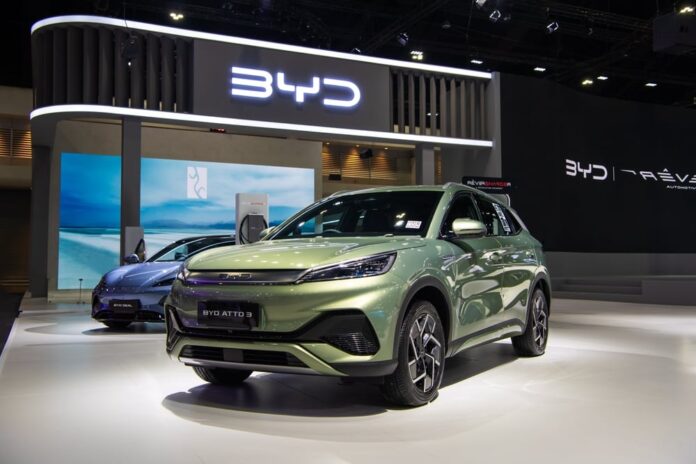BYD, the Chinese electric vehicle (EV) giant, shocked the automotive world with its latest battery technology. The company announced a breakthrough that allows its new batteries to charge in just 5 minutes, adding 400 kilometers (249 miles) of driving range. This could solve one of the biggest problems for EV owners—long charging times.
The innovation has made waves in the industry, boosting BYD’s stock and putting pressure on rivals like Tesla. How does this new development impact the market? Is it for real? Let’s uncover the truth.
Charging Ahead: The Rise of BYD
BYD, which stands for “Build Your Dreams,” is one of the world’s largest EV manufacturers. The company produces both battery-electric and plug-in hybrid vehicles and has seen rapid growth in recent years. It has surpassed Tesla in global EV sales in 2024 and continues to expand its presence worldwide.
The latest advancement in fast-charging technology has put BYD ahead of the competition. The company’s new charging system allows EVs to be powered up in almost the same time it takes to fill a gasoline car. This breakthrough could encourage more people to switch from traditional cars to EVs.
BYD’s founder Wang Chuanfu remarked on this announcement, stating:
“To completely solve users’ anxiety over charging, our pursuit is to make the charging time for EVs as short as the refuelling time for fuel vehicles.”
How Does the New Battery Work?
BYD’s new battery can receive one megawatt (1,000 kilowatts) of power, significantly cutting charging times. This is possible because the battery has lower internal resistance, reducing heat buildup when charging at high power. The first BYD models to use this technology will be the Han L sedan and the Tang L SUV.
For comparison, Tesla’s superchargers can provide enough power in 15 minutes for about 172 miles (277 km) of driving. Other Chinese competitors, such as XPeng and Zeekr, offer 5C and 5.5C charging systems that add about 280–342 miles (450–550 km) of range in 10 minutes. BYD’s new battery outperforms them all, making it the fastest-charging battery available.
Market Impact: Tesla vs. BYD – Can Elon Musk Keep Up with China’s EV Giant?
This breakthrough has had an immediate impact on the stock market. After the announcement, BYD’s Hong Kong-listed shares jumped by 4.1%, reaching a record high.
Investors think BYD’s new tech will boost its market position. It may also attract more customers who worry about charging their EVs.
Meanwhile, Tesla’s shares fell by nearly 5% following BYD’s announcement. The news has led many to question whether Tesla, once the leader in EV technology, can keep up with BYD’s rapid advancements.
BYD and Tesla are in an intense battle for EV market dominance. While Tesla remains a global leader, BYD has surpassed it in key areas.
In Q4 2024, BYD sold 1.52 million vehicles, tripling Tesla’s sales. The company’s low costs and vertical integration give it a big advantage. This lets it make EVs profitably for less than $25,000 each. Tesla, on the other hand, still struggles with maintaining profit margins, especially as it relies heavily on China for sales.
The Chinese carmaker is also expanding rapidly into international markets, aggressively pushing into Europe and emerging markets. Its next-generation hybrid systems and ultra-fast charging technology further strengthen its competitive position.
While Tesla still dominates in the U.S., BYD’s lower production costs and new battery advancements could help it gain further market share globally. As both companies continue to innovate, the EV race is far from over.
BYD’s Charging Network Expansion
To support its new ultra-fast charging technology, BYD plans to build more than 4,000 megawatt “flash-charging stations” across China. These stations will allow drivers to take full advantage of the five-minute charging capability.
The company hasn’t announced when the rollout will be finished. Still, it’s clear that BYD is putting a lot of money into infrastructure for its new battery technology.
Challenges and Limitations
Despite the excitement, there are some challenges to consider. Ultra-fast charging requires a lot of power, which could put pressure on electricity grids. Also, installing high-powered charging stations costs a lot. Many places still lack the needed infrastructure.
Another potential issue is battery health. Charging a battery at such high speeds could reduce its lifespan over time. However, BYD has stated that its new battery is designed to handle frequent fast charging without significant degradation.
This battery technology achievement is very significant to the increased adoption of EVs, considering that this clean tech transport is essential to achieving net zero and other climate goals.
Beyond Speed – The Environmental Impact of EVs and Carbon Credits
Electric vehicles play a crucial role in reducing greenhouse gas (GHG) emissions. In 2021, plug-in EVs, including all-electric and plug-in hybrid models, prevented approximately 5.5 million metric tons of carbon dioxide (CO₂) emissions in the United States. This reduction is equivalent to removing over 1.1 million gasoline-powered cars from the road for a year.
The positive impact of EVs has grown annually. By 2023, the increased adoption of EVs contributed to an 11% decrease in CO₂ emissions from new vehicles, lowering the average to 319 grams per mile—a historic low.
Carbon credits further support emissions reduction by allowing companies to offset their GHG emissions. Automakers can buy these credits to meet environmental rules. This helps boost investment in clean energy and sustainable practices.
Honda and Suzuki joined Tesla’s CO₂ emissions pool in 2025. They did this to meet the European Union’s strict CO₂ reduction rules. This move shows how carbon credits help companies comply and work together in the industry. BYD also teamed up with other carmakers in the EU for carbon credit pooling.
EVs cut CO₂ emissions and carbon credits help companies hit their environmental goals. This speeds up the shift to cleaner transport. With more reduction in charging times, BYD’s breakthrough further helps slash the carbon pollution of the mobility sector.
The Future of EV Charging
The introduction of ultra-fast charging technology is a major milestone in the EV industry. It addresses one of the biggest concerns for consumers—charging time. If BYD can successfully implement this technology on a large scale, it could drive higher adoption of EVs worldwide.
With countries pushing for stricter emissions regulations and phasing out gasoline cars, advancements like this could accelerate the transition to electric transportation. Other automakers will likely try to catch up, leading to further innovations in battery technology.
As the EV competition heats up, all eyes are on Tesla and other automakers to see how they respond. One thing is clear—BYD is shaping the future of electric mobility.


